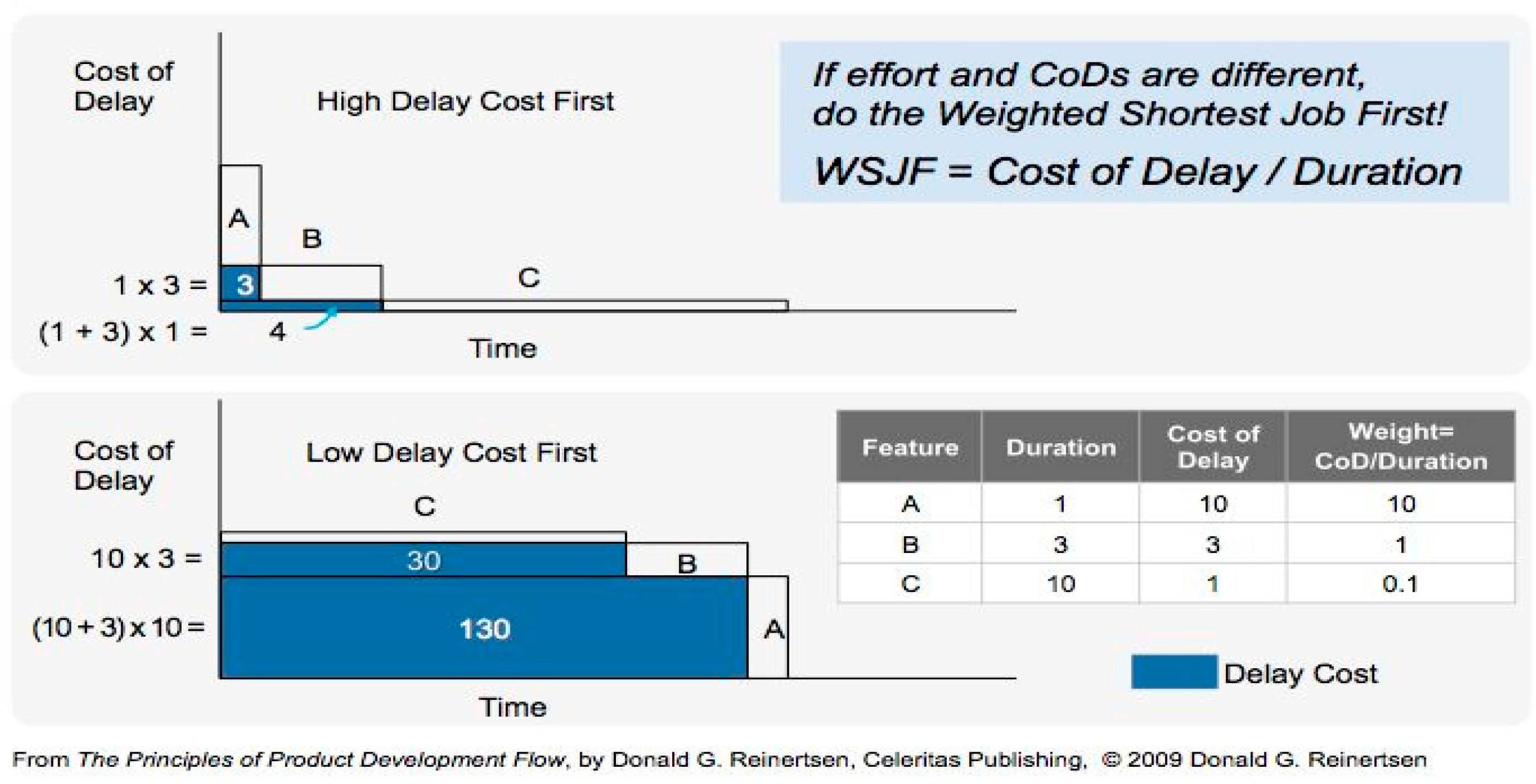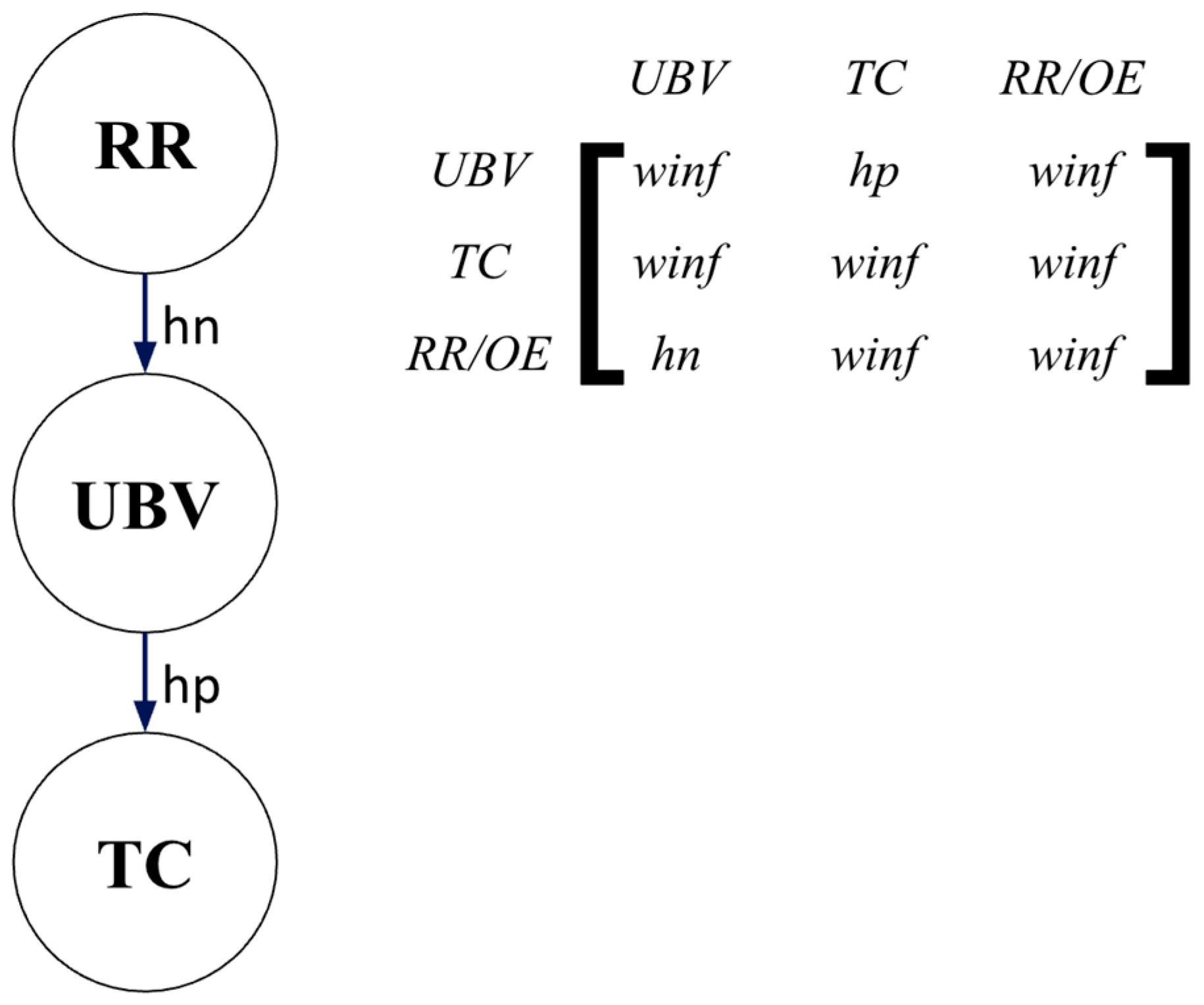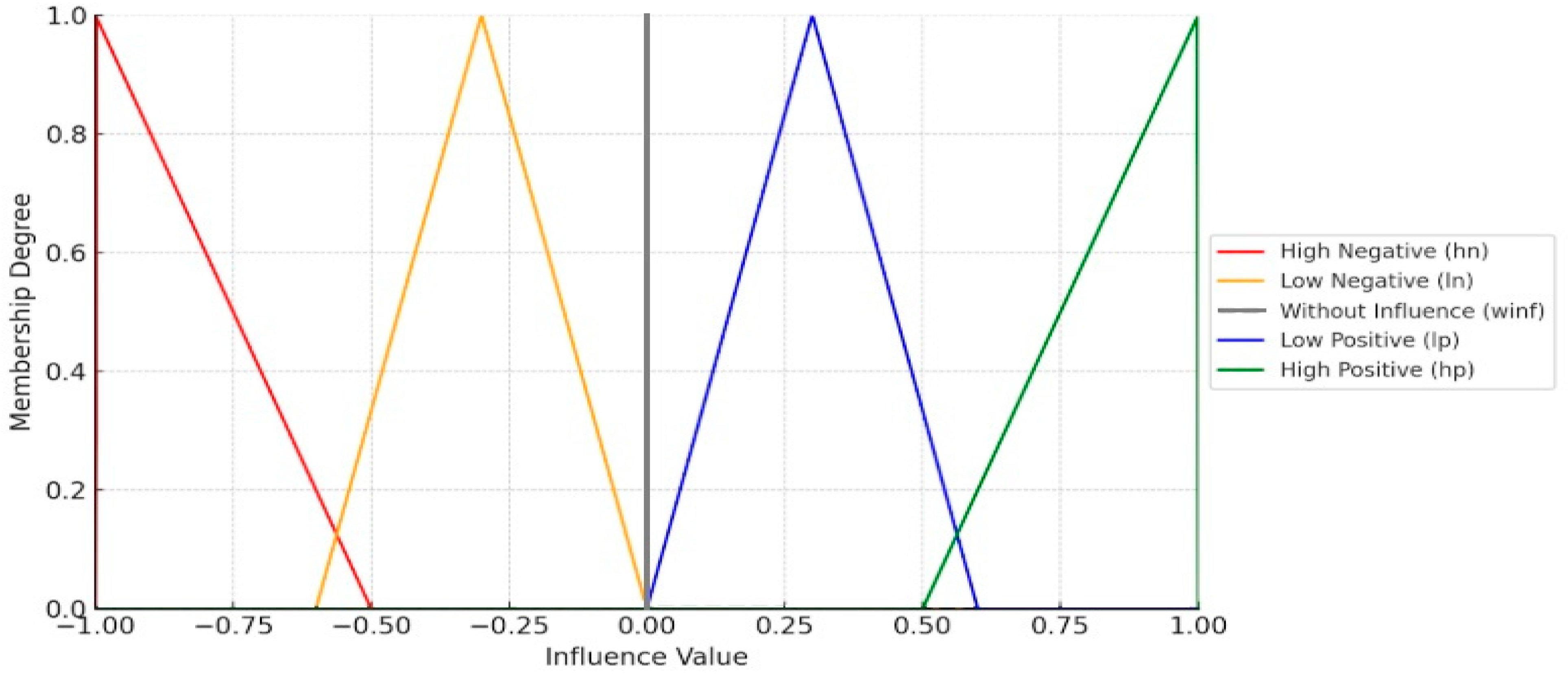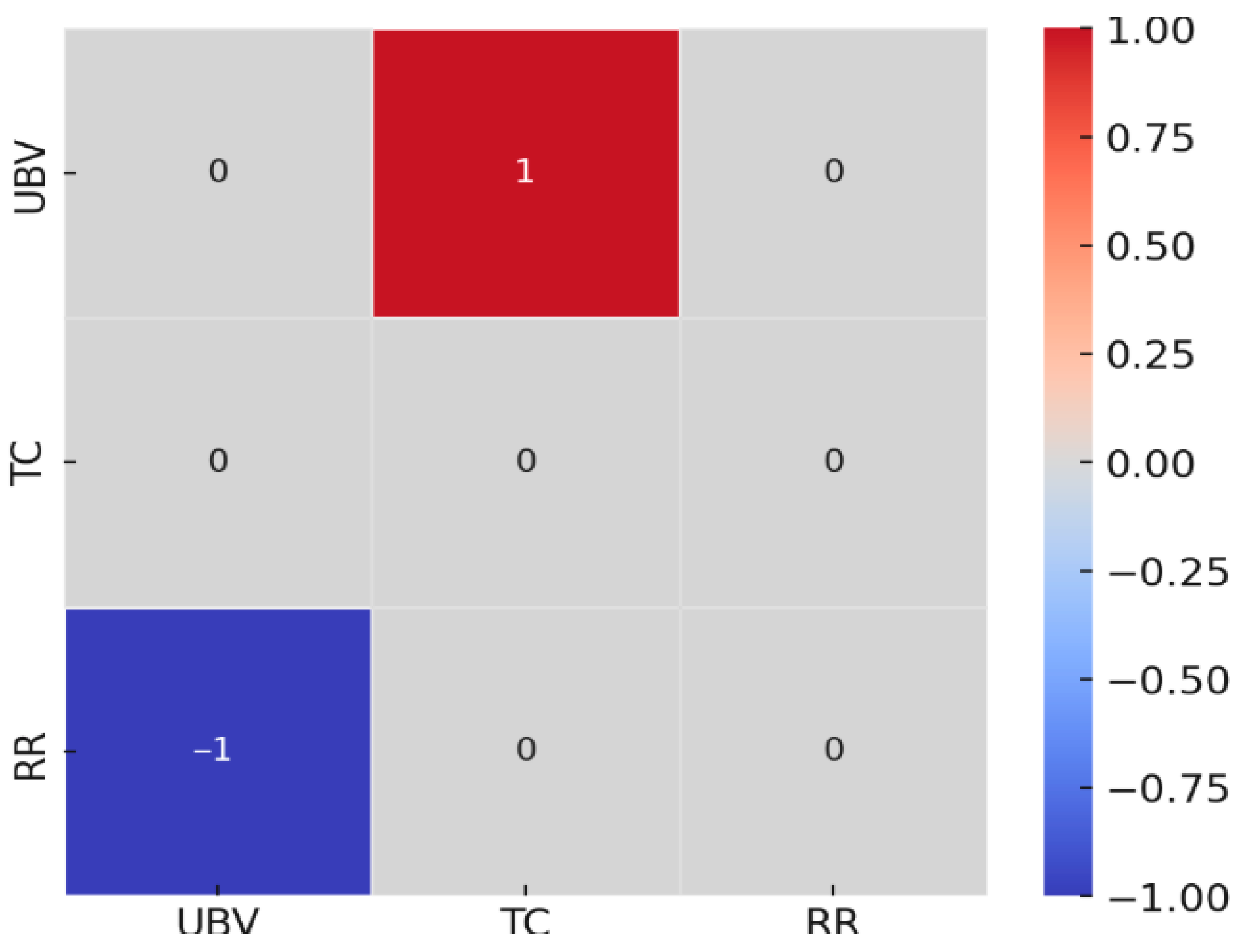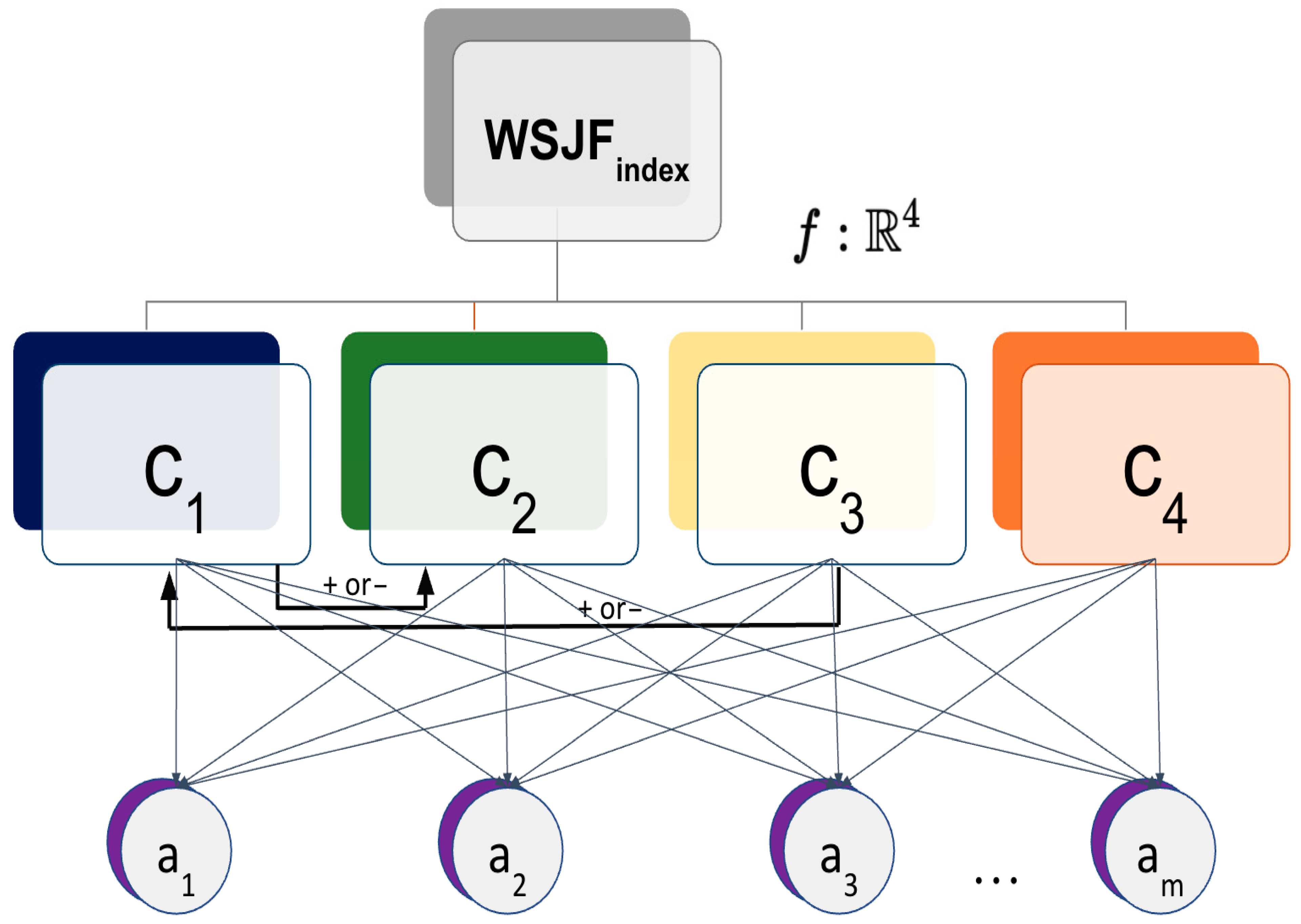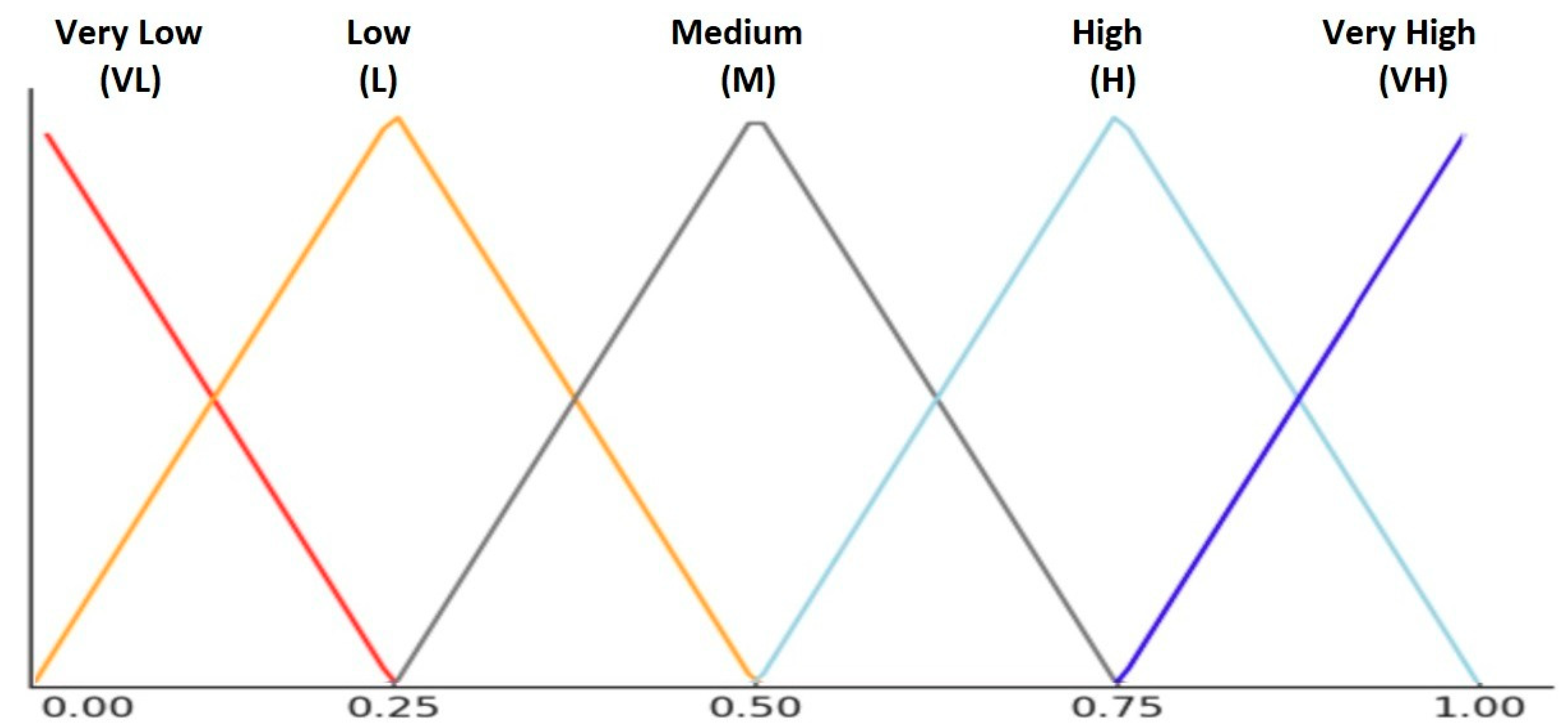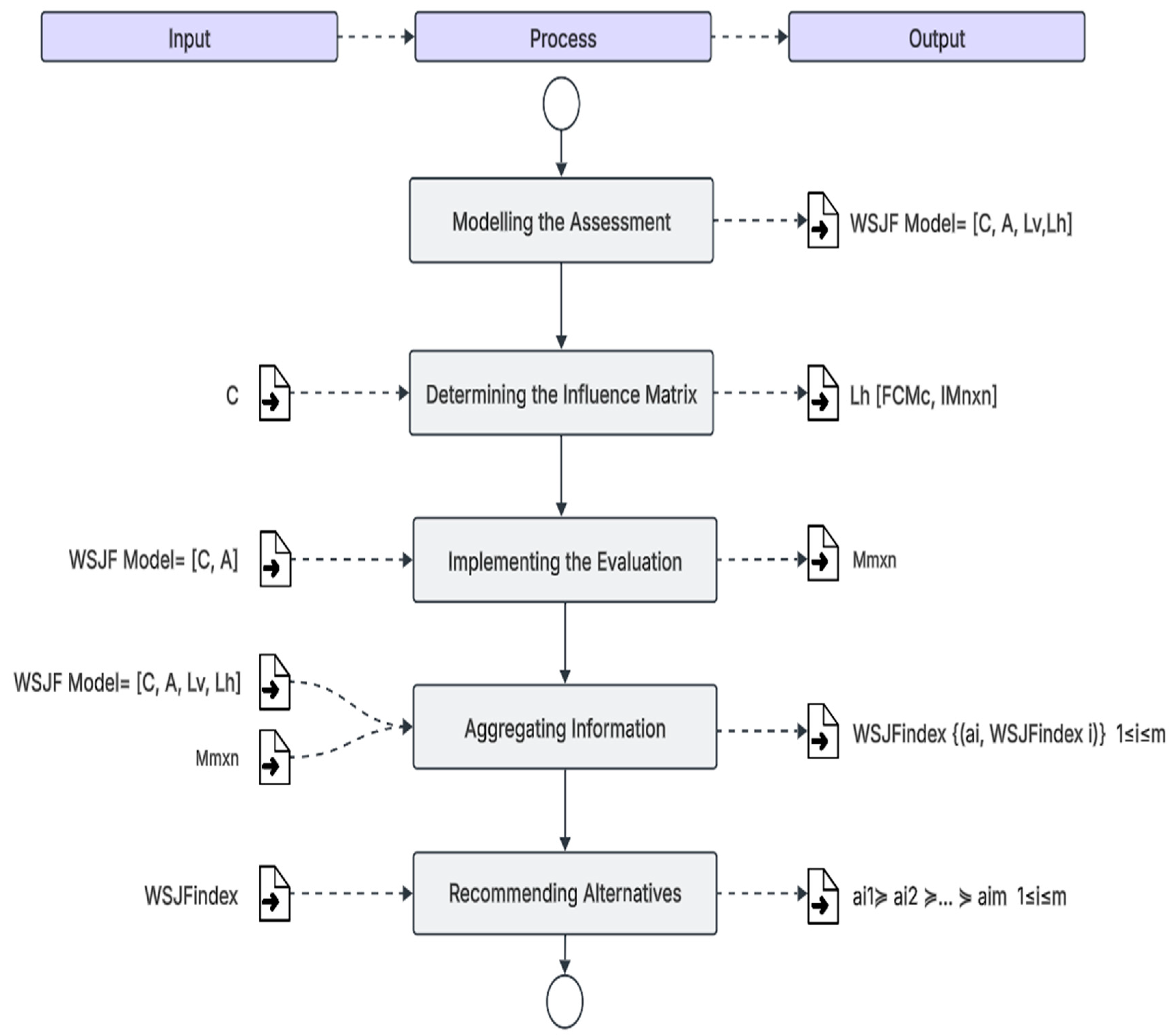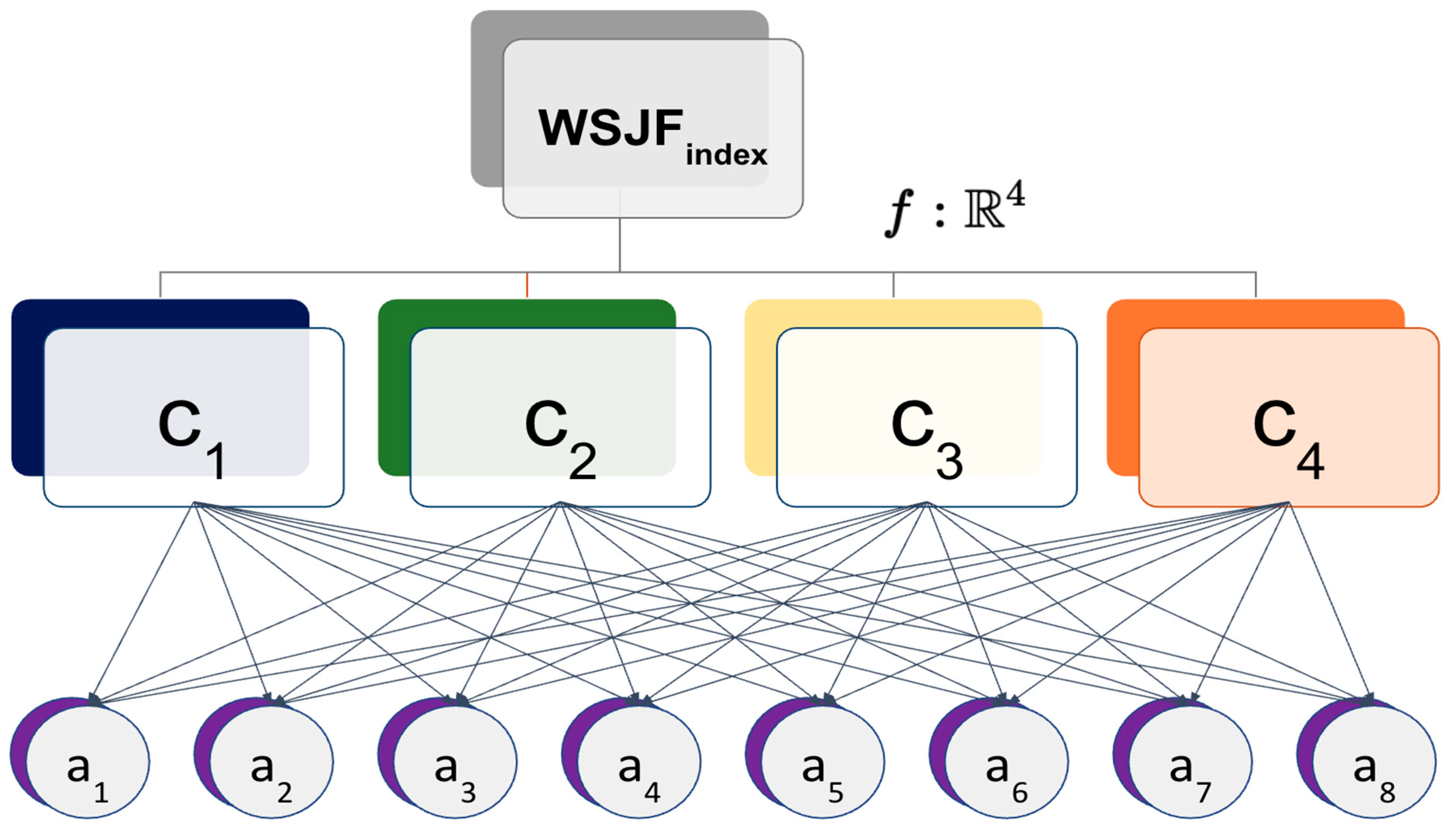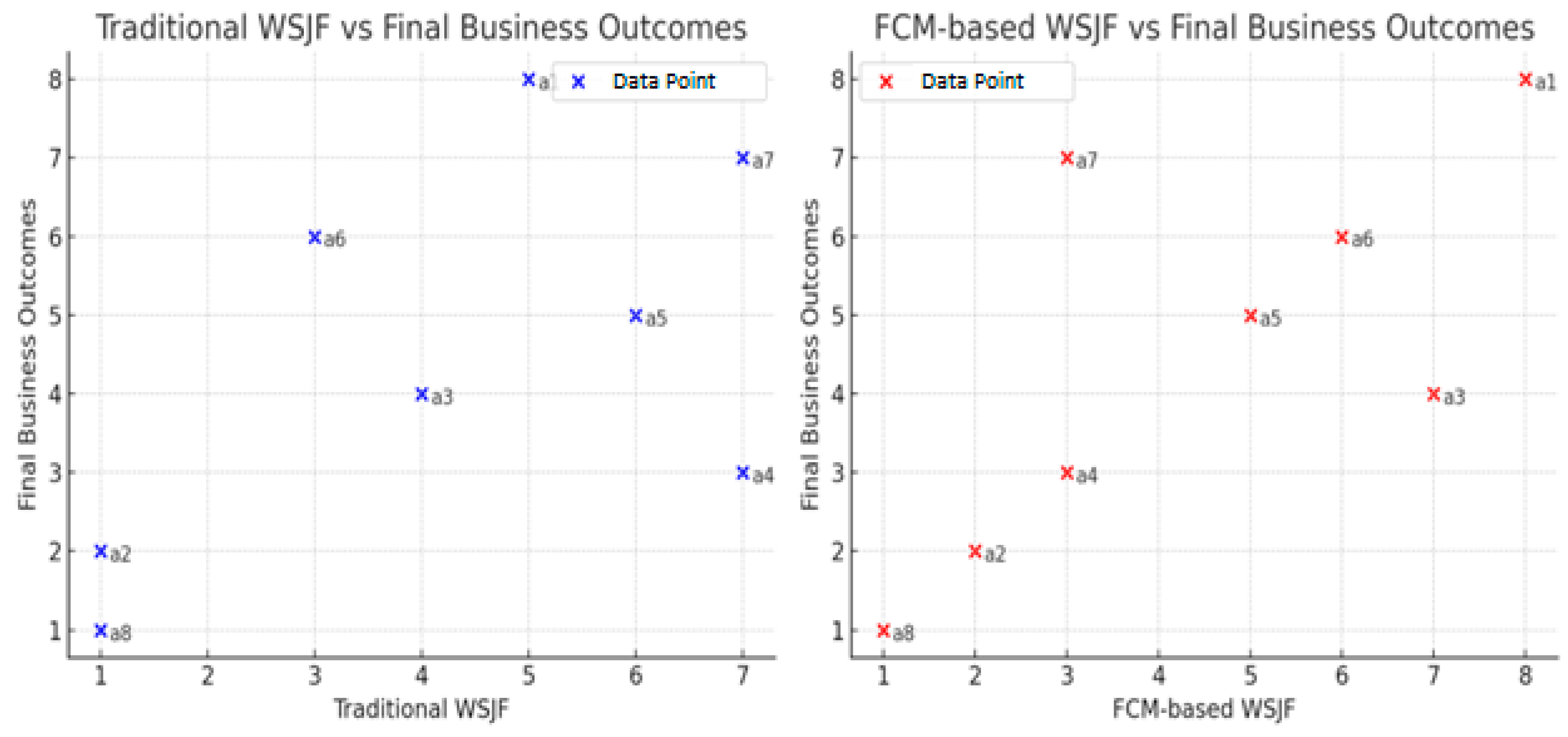1. Introduction
Currently, digital innovation and transformation are some of the main pillars of organizations seeking to develop new products, services, or business models using agile project approaches. In this context, the decision-making process in volatile, uncertain, complex, and ambiguous (VUCA) environments, as described by [
1], involves the use of prioritization techniques such as Weighted Shortest Job First (WSJF) by [
2], as shown in
Figure 1. The WSJF model is gaining significant importance today because it allows alternatives to be prioritized based on the greatest business value and the least effort. Leading global organizations such as the LEGO Group (Billund, Denmark), AT&T (Dallas, TX, USA), Cisco (San Jose, CA, USA), and Fitbit (San Francisco, CA, USA) have adopted this technique as part of their decision-making processes.
WSJF can be theoretically outlined as a multi-criteria decision-making (MCDM) technique [
3], where multiple evaluation criteria—user business value, time criticality, risk reduction, and job size—are assessed to determine priority. Additionally, WSJF involves multiple decision-makers, aligning with the wisdom of crowds theory [
2], which advances that collective judgment can improve decision quality under uncertainty.
The WSJF prioritization formula calculates the Cost of Delay (CoD) as the sum of user business value, time criticality, and risk reduction, divided by job size. This ratio guides decision-makers to select alternatives that deliver the highest value in the shortest time, optimizing resource allocation [
4]. Although there is no statistical data on the percentage of use of WSJF,
the Pulse of the Profession Report [
5] notes that more than 65% of organizations today are using agile or hybrid approaches and therefore may be applying WSJF.
However, a key limitation persists: WSJF is applied in a linear manner, where each variable is considered independently, and interactions among variables are not formally accounted for. Prior approaches have emphasized the relative importance of individual factors but have not provided mechanisms to model causal feedback loops, nonlinear dependencies, or dynamic changes in relationships over time. As a result, traditional WSJF does not capture the complexity of decision-making in VUCA environments, where the influence of one criterion (e.g., risk reduction) can significantly alter the interpretation of another (e.g., business value).
This gap is critical because it restricts WSJF’s ability to reflect real-world decision dynamics. Addressing this, Fuzzy Cognitive Maps (FCMs) [
6,
7] have emerged as a valuable tool for modeling and analyzing complex systems [
8]. Unlike linear models, FCMs allow for the representation of fuzzy and nonlinear causal relationships, capturing interdependencies and feedback effects between variables. Their ability to incorporate degrees of influence, uncertainty, and dynamic adjustment makes them particularly suitable for decision-making problems in agile project management. Recent studies demonstrate the effectiveness of FCMs in diverse fields—from social systems and neural networks to gene regulatory modeling [
9,
10,
11]—underscoring their robustness for contexts characterized by complexity and uncertainty.
Therefore, this research directly addresses the identified gap by applying FCM to WSJF, creating a decision-making model that explicitly captures variable interdependence. By integrating fuzzy logic, linguistic modeling, and cognitive mapping, the proposed model moves beyond the traditional independent-variable assumption of WSJF and provides a more dynamic, responsive, and theoretically grounded framework for prioritization in complex environments.
The use of these tools allows for diverse applications ranging from the simulation of social systems to the prediction of behavior in neural networks and the generation of probabilistic forecasts such as those carried out in research studies with fuzzy time series as proposed by [
12,
13]. The application of FCMs has even extended to the field of gene regulatory networks, where they have been used to infer models from gene expression data, as investigated by [
9], highlighting their ability to model complex interactions within biological systems. On the other hand, [
10] demonstrated the effectiveness of FCMs combined with evolutionary algorithms in reconstructing gene regulatory networks, highlighting the potential of FCMs in managing complex and interdependent variables.
Similarly, [
11] explored the scalability of FCMs using a hybrid approach combining memetic algorithms and neural networks, providing a robust framework for learning large-scale cognitive maps, which can be particularly beneficial in the WSJF context, and other authors such as [
14] present an innovative approach to improve the adaptability and learning efficiency of FCMs in dynamic environments.
Ref. [
15]’s research shows how the combination of hybrid learning with evolutionary optimization opens new possibilities to improve the robustness and interpretability of FCM-based decision models as also supported by [
11,
16,
17]. All these advances cited above are particularly relevant in the context of decision making using WSJF, where accuracy and adaptability are crucial for success. Another interesting example of the use of FCM is the multi-criteria evaluation model for software quality based on soft computing techniques, such as fuzzy logic and Fuzzy Cognitive Maps, which manage heterogeneous, imprecise, and uncertain data from various sources [
18].
In the decision-making process, the use of FCM to analyze the interdependence of variables in WSJF offers a novel perspective, because it allows to explicitly model how changes in one variable can affect others, which offers decision makers to better anticipate the results of their actions, so that these practices have already been implemented in virtual or digital worlds, as explained by [
19].
The Weighted Shortest Job First (WSJF) method remains one of the most adopted prioritization techniques in Agile frameworks, particularly within the Scaled Agile Framework (SAFe), due to its balance between value delivery and cost of delay. However, as organizations evolve toward hybrid and adaptive project environments, the linear and independent assumption of WSJF variables becomes a significant limitation. Real-world prioritization scenarios involve interdependent and dynamic variables—such as business value, risk reduction, and job duration—that influence each other nonlinearly.
To address this limitation, this research introduces an enhanced WSJF approach using Fuzzy Cognitive Mapping (FCM). FCM enables the modeling of causal interdependencies between WSJF criteria through fuzzy logic and directed graphs, allowing for the representation of uncertainty, feedback loops, and variable influence strengths. Unlike traditional linear or AHP-based methods, FCM captures systemic interactions without requiring large datasets or rigid hierarchies, making it suitable for agile and uncertain environments.
This research contributes by developing a decision-making model that applies FCM to WSJF, improving the prioritization of alternatives compared to conventional WSJF methods. By leveraging fuzzy logic, fuzzy linguistic modeling, and FCM, the proposed model addresses the theoretical gap in WSJF’s treatment of variable interdependence and uncertainty. This approach offers a more dynamic, responsive, and theoretically grounded framework for project prioritization in complex, uncertain environments.
The article has been structured in five main sections.
Section 1 presents an introduction and the relevance and objective of the study.
Section 2 reviews the existing literature to position the research within the academic field, making a comparative analysis of related studies.
Section 3 describes modeling interdependencies with Fuzzy Cognitive Maps.
Section 4 presents a case study of the proposed model with its Model, Assessment Method, and Case Study Results applying FCM to the WSJF prioritization technique. Finally,
Section 5 includes the main discussions, conclusions, and key findings of the article.
2. Related Works
Although there is no literature related to studies or research on decision-making optimization using WSJF with Fuzzy Cognitive Maps, articles have been found that address the problem independently, that is, some address the problem of prioritization in decision-making with a particular technique and others the application of Fuzzy Cognitive Maps in decision-making without using any prioritization technique.
Authors such as [
20,
21] have developed research on the application of the WSJF prioritization technique in the field of technology and the impact it produces to mitigate adverse effects of low performance in computing systems, as well as the prevention of poor estimates on the size of the calculated work that affects the performance of the systems.
Other research has been conducted on prioritization in decision making, such as that of [
22] which presents how, from the user’s perspective, business options are prioritized in the field of technology (Internet of Things—IoT) by applying the MoSCoW prioritization technique. On the other hand, refs. [
23,
24] developed their research on prioritization using the Kano model technique applied to the fields of health and education, respectively, which is a significant reference that it is feasible to apply FCM on prioritization techniques, as in this case WSJF (for further details, see
Table 1).
Addressing the application of FCM for the decision-making process, it has been found that [
25] have investigated how the use of FCM in decision-making support in the field of medicine significantly improves accuracy and efficiency when making diagnoses, executing treatments, or identifying symptoms, which represents an important advance in the medical area.
Ref. [
16] suggest that the integration of fuzzy logic and multi-criteria decision-making techniques can be combined to handle the complexity; their research discusses various approaches, including fuzzy AHP, fuzzy TOPSIS, fuzzy inference systems, and hierarchical aggregation models that combine expert judgments with objective metrics.
On the other hand, authors such as [
26] have proposed the use of FCMs to model the interdependence of various factors that affect risks in complex systems, such as technology, human behavior, and external conditions. Other research by [
4] addresses how FCMs help improve decision making in dynamic environments, where rapid changes and complex relationships between variables make prediction and analysis difficult. Finally, ref. [
3] highlights how FCMs are used in collaborative processes that allow representing the vision of multiple stakeholders and managing uncertainty and conflicts of interest in the decision-making process.
From another perspective, ref. [
19] presents advanced methodologies for evaluating software usability through the integration of fuzzy logic, Fuzzy Cognitive Maps (FCMs), and interdependence matrices. This novel approach captures the influence and interrelations among sub-criteria and incorporates constraints on essential factors to produce a comprehensive usability index. As illustrated in
Table 2, a general summary of the works related to prioritization using the WSJF technique with FCM is presented, and as can be observed, there is no previous scientific literature that comprehensively addresses the problem. Although these studies contribute significantly to the research field, there is still a gap in the literature regarding the explicit integration of FCMs into decision-making processes, especially through the application of WSJF.
FCMs are presented as a highly efficient option to help mitigate the problem of decision-making in highly uncertain environments, because they allow us to identify the interdependence in their models and the influence between their nodes, as well as the impact that occurs because of the relationship. Ref. [
7] introduced a comprehensive approach that integrates multiple metrics and criteria through Fuzzy Cognitive Maps (FCMs), allowing for the modeling of interdependencies and expert opinions.
While WSJF operates without considering the dependencies of its variables, there are techniques that allow working with nonlinear models such as ANP [
25], which effectively models interdependencies, although it requires extensive pairwise comparisons, which limits scalability in dynamic environments. On the other hand, ELECTRE [
27] incorporates uncertainty but lacks the ability to represent feedback loops between criteria. However, FCM improves WSJF by dynamically capturing the causal influence between variables. The study demonstrates that applying FCM to WSJF increases alignment with current business outcomes, as evidenced by a stronger correlation with ultimate revenue performance.
3. Modeling Interdependencies with Fuzzy Cognitive Maps
This section describes the methodology used to analyze the interdependence and influence of WSJF variables on the decision-making process by applying Fuzzy Cognitive Mapping. The research will be developed through the representation of the Fuzzy Cognitive Map, the model’s linguistic labels, and the WSJF Variable Interdependence Mapping.
Fuzzy Cognitive Maps (FCMs) are widely used for quantitative modeling. They are based on expert knowledge and experience and consist of a directed fuzzy graph. FCMs are frequently used to represent and model complex interdependencies between variables. For the present research,
Figure 2 represents the WSJF FCM, which illustrates the relationship between the nodes of the fuzzy graph, considering the relationships between the variables Business Value to the User (BV), Risk Reduction or Opportunity Enablement (RR), and Critical Time (TC). In this context, the image illustrates the interdependence between the variables RR and UVB with a negative influence and, on the other hand, the interdependence between the variable UBV and TC with a positive influence.
However, to evaluate each variable within the model, it is necessary to define a range of values that represent the impact on each according to the decision-makers’ criteria and it is represented through the Fuzzy Triangular Numbers.
In order to define the BSE series to be used in the model,
Table 3 presents the Linguistic Labels that have been defined, i.e., the semantic rule of the model. For greater clarity, the description of their membership range, their membership function and the degree of membership of each linguistic label have been included, taking values in the universe U = [−1, 1] according to the Bucket System Estimation scale and its set of terms T (influence) is:
Figure 3 shows fuzzy membership functions for the levels of influence that occur between variables, each interval corresponding to a linguistic label that defines the strength of an influence, ranging from High Negative Influence (HN) to High Positive Influence (HP), including a No Influence (WINF) category at zero. The
x-axis represents the influence values, ranging from −1 to 1, while the
y-axis represents the degree of membership (μ), which indicates how strongly a given value belongs to a particular fuzzy set (ranging from 0 to 1).
On the other hand,
Table 4 provides a detailed representation of the interdependencies between the WSJF variables. It achieves this by applying the predefined linguistic labels and their corresponding membership functions, which are integral to the model’s framework. Each variable’s membership function helps quantify the relationship between the linguistic labels (e.g., low, medium, high) and their associated numerical values, providing a more nuanced understanding of how these variables interact.
Additionally, the table includes the value scales for each linguistic label, which are used to determine the degree to which each variable aligns with a particular label. This scale allows for a consistent application of the model across different contexts and projects. It is important to note that the Job Size variable is excluded from this analysis, as it is considered an independent variable that does not directly interact with the other variables in the matrix. This exclusion helps to focus the analysis on the interdependence among the remaining variables, such as User Business Value (UBV), Time Criticality (TC), and Risk Reduction (RR).
Another way to better illustrate the level of intensity in the dependencies of the WSJF variables is represented in
Figure 4, through a heat map, where the level of intensity is expressed by applying the membership functions of the linguistic labels. As can be seen, there is a high level of dependence with a negative influence of high intensity between the variables RR and UBV
and a high level of dependence between the variables UBV and TCV
with a positive influence of high intensity.
5. Discussions
The analysis of linear systems in the decision-making process is crucial due to the risks associated with potential interdependencies between variables. The results obtained indicate that the use of evaluation models under these conditions can lead to incorrect decisions if these interdependencies are not properly identified. Therefore, developing the ability to identify such relationships in the evaluated models is essential to ensure the reliability and accuracy of the decision-making process.
The results of this research show that incorporating FCM into WSJF provides a clearer, more accurate prioritization of business alternatives compared to the traditional model. While conventional WSJF produced ambiguous rankings due to identical scores for multiple alternatives, the FCM-based approach successfully differentiated among them, reducing uncertainty for decision-makers. This demonstrates that modeling interdependencies among variables not only improves predictive accuracy but also enhances the robustness of prioritization outcomes in complex organizational settings. Furthermore, the higher correlation between FCM-based WSJF and actual business performance outcomes suggests that this approach bridges the gap between theoretical prioritization methods and real-world organizational needs.
The research highlights the importance of understanding the interdependencies between variables in complex systems, as these relationships can significantly influence model results. In particular, if the interactions between variables are not properly considered, the model could offer erroneous results that affect the final decision and, consequently, business results. Consequently, identifying interdependencies accurately is essential to improving the effectiveness and reliability of the models used in decision-making.
The research findings are consistent with previous studies that have emphasized the need to consider the interdependence of variables in decision making within complex systems [
19,
27]. However, the approach adopted in this article, which integrates a detailed analysis of interdependencies within an assessment model, offers a more rigorous perspective than previous studies that have focused primarily on systems assessment without exploring these dynamic relationships in depth.
As practical and theoretical implications, identifying and assessing the interdependencies between variables not only improves the accuracy of the assessment model but also contributes to the reliability of decisions made in complex and changing environments. Therefore, from a practical perspective, implementing this approach could be especially valuable in industries such as manufacturing, technology, or project management, where decision-making relies on models involving multiple interrelated variables.
Nevertheless, this study also reveals important limitations. The analysis was conducted on a single banking case study, which restricts the generalizability of the results. Moreover, although FCM enhances interpretive power, the model’s outputs still require translation into actionable managerial guidelines. For example, while the results indicate that project a8 should be prioritized, managers must also understand how to interpret the fuzzy weights and causal influences that underpin this ranking. Without clear frameworks for interpretation, the risk remains that practitioners may treat the model as a “black box,” reducing transparency and stakeholder trust. Addressing these challenges is essential for broader adoption.
Although FCM provides a powerful mathematical representation of interdependencies, its fuzzy weights can be complex to interpret for non-technical practitioners. To enhance usability, this study proposes a managerial interpretation framework based on visual decision-support dashboards. These dashboards translate fuzzy influence weights into intuitive cause–effect diagrams, enabling managers to visually explore how changes in one WSJF criterion (e.g., risk reduction) impact others (e.g., business value). Such visualizations bridge the gap between analytical modeling and executive decision-making, facilitating adoption in agile portfolio management tools.
6. Conclusions and Future Works
The study concludes that the integration of FCM into WSJF significantly improves prioritization accuracy, as evidenced by the stronger correlation (0.711) with actual business outcomes compared to the conventional model (0.287). This reinforces the argument that decision-making frameworks must evolve beyond linear and independent-variable assumptions to remain relevant in complex environments. The case study demonstrates that organizations can achieve more reliable and strategically aligned outcomes when systemic interdependencies are explicitly modeled.
The most relevant conclusion of the research is that, according to the results obtained, a notable improvement is observed in the differences in outcomes between decisions made using linear WSJF and those using WSJF applying FCM, due to the better approximation of results with FCM.
Considering that the research included a post-mortem analysis, the results show that applying FCM to WSJF had a 76% correlation in the prioritization order of the best results; however, a 24% difference was observed in said order, which remains a gap that needs to be investigated. Therefore, this correlation percentage suggests a notable improvement in decision-making efficiency, and the challenge would be to test the model in other industries.
However, the research also highlights critical limitations that must guide future work. First, the validation of the model through a single banking case restricts external validity; expanding the application to diverse industries—such as healthcare, manufacturing, or digital services—would provide evidence of robustness and scalability. Second, while FCM captures interdependencies, interpretability remains a challenge. Future research should focus on developing visualization tools, decision-support dashboards, and practitioner guidelines to help managers translate model outputs into concrete actions. Finally, benchmarking against other state-of-the-art methods such as ANP, ELECTRE, or hybrid fuzzy approaches would provide a stronger comparative foundation for the proposed model’s effectiveness.
Another relevant aspect is that the techniques compiled in this work can be incorporated into a recommendation system that can be developed in several phases: (a) in the initial phases, the system can use this and/or other fuzzy techniques along with 75% human intervention; (b) In the production phases, the recommendation system can have 50% human interaction to guide the decision-making process; (c) subsequently, the recommendation system can have zero human intervention in decision-making, following ethical guidelines.
The enhanced model achieved a 76% correlation between FCM-based WSJF prioritization and actual business results, compared with 24% divergence from the traditional WSJF approach. These figures—derived from the post-mortem case study and visualized in
Figure 9—demonstrate that modeling interdependencies among WSJF variables substantially improves predictive validity and prioritization precision.
The correlation values were obtained by comparing the rank-order correlation (Spearman’s ρ = 0.711, p < 0.05) between the FCM-based model and real business outcomes, confirming statistical significance. Conversely, the linear WSJF model yielded ρ = 0.287 (p > 0.05), indicating a weak and non-significant association. Therefore, the 76% concordance refers to the overlap in ranking order, while the 24% residual variation identifies cases where nonlinear dependencies altered prioritization (notably alternatives a4 and a7).
Future work should focus on expanding this approach across multiple sectors and scaling it into real-time decision-support platforms. Moreover, incorporating automated learning mechanisms to update FCM weights from project performance data could further enhance adaptability and predictive reliability. Additionally, future research can be focused on the following, for instance: (1) validating the model across multiple sectors to enhance generalizability, (2) incorporating automated weight learning in FCM to adapt influence matrices from real performance data, (3) comparing computational scalability (O(n2) relationships) with other MCDM techniques such as ANP and ELECTRE, (4) Developing visual decision-support dashboards for intuitive interpretation of fuzzy interactions by managers.
As a conclusion, the application of FCM can be extended to other prioritization techniques to verify whether the behavior is similar to the current model and improve the final decisions.
Limitations
One of the main limitations of this study is that the results obtained are based on a specific set of assessment models. Although these results are relevant, further studies are needed to validate the findings in different contexts and with various methodologies. Furthermore, the applicability of this approach could be influenced by the quality of the available data and decision-makers’ interpretation of interdependencies.
